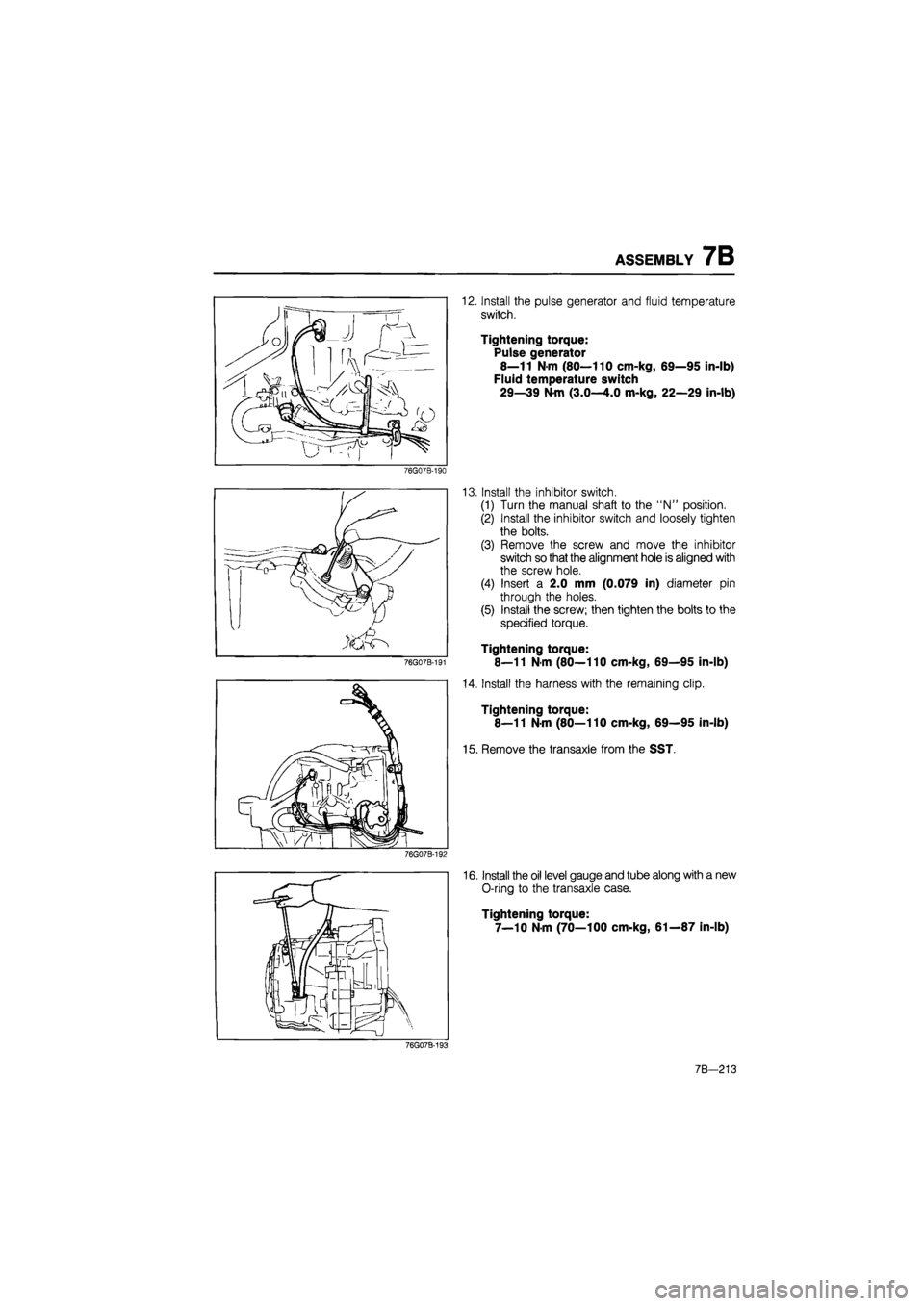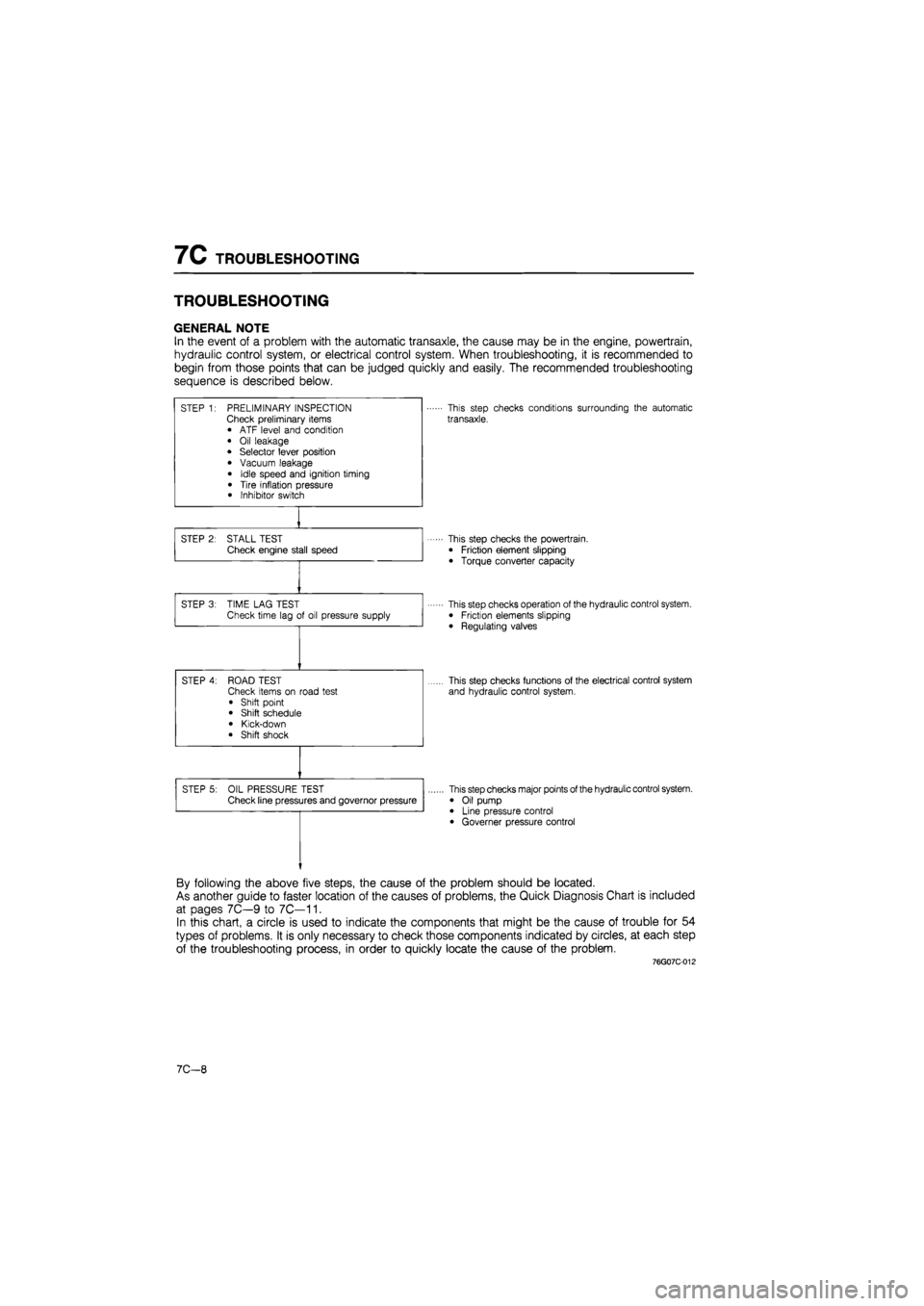Page 910 of 1865
7B TROUBLESHOOTING (G4A-HL)
STEP 1 (PRELIMINARY INSPECTION)
In this step, the fundamental points related to the automatic transaxle are checked. These points must
be kept in the correct condition at all times in order to assure proper operation of the automatic transaxle.
83U07B-025
1. Automatic Transaxle Fluid (ATF)
Check ATF level and condition. (Refer to page
7B-71)
76G07B-043
11
m
0 £
m
0 •
o #
m
Button need not
^ be depressed
Button must be pressed
2. Selector Lever
Check selector lever position and adjust if neces-
sary. (Refer to page 7B—72)
76G07B-044
3. Oil Leakage
Check for oil leakage.
(1) Warm up the ATF.
(2) Apply the parking brake and block the wheels
to prevent the vehicle from rolling.
(3) Shift the selector lever to R range.
(4) Check if oil leaks from the following oil seals
or gaskets.
(5) If oil leaks, replace the oil seal or gasket.
76G07B-215
7B—44
Page 915 of 1865
TROUBLESHOOTING (G4A-HL) 7B
STEP 3 (STALL TEST)
This step is performed to determine if there is slippage of the friction elements or malfunction of the
hydraulic components.
Preparation
Check the following items prior to testing:
1. Engine coolant, engine oil and ATF levels.
2. Warm the engine thoroughly to raise the ATF temperature to operating level (50—80°C, 122—176°F).
3. Engage the parking brake and use wheel chocks at the front and rear wheels.
Pull the parking brake Water temperature
ATF
83U07B-038
7B—49
Page 937 of 1865

ON-VEHICLE MAINTENANCE 7B
ON-VEHICLE MAINTENANCE
AUTOMATIC TRANSAXLE FLUID (ATF)
Inspection for Fluid Leaks
Check for fluid leaks; the following figure shows the locations where fluid leakage may possibly occur.
1. Oil pan
2. Control valve body cover
3. Oil pump
4. Inhibitor switch
5. Speedometer driven gear
6. Pulse generator (G4A-EL)
7. Oil filler tube
8. Throttle cable
9. Bearing cover
76G07B-085
10. Driveshaft
11. Square head plug
12. Transaxle case
13. Drain plug
14. Oil cooler return pipe
15. Oil cooler outlet pipe
16. Fluid temperature switch (G4A-EL)
17. Blind plugs
18. Governor cover (G4A-HL)
Inspection of Level
1. Apply the parking brake and position wheel chocks
to prevent the car from rolling forward.
Note
Place the car on a flat, level surface.
2. Run the engine so that the automatic transaxle fluid
reaches specified temperature.
3. While the engine is idling, shift the select lever from
P to L or P to 1 and back again.
4. Let the engine idle.
5. Shift the select lever to P.
76G07B-086
7B—71
Page 944 of 1865
7B ON-VEHICLE MAINTENANCE
Installation
Install in the reverse order of removal referring to in-
stallation note.
Installation note
Control valve body
Install the control valve body.
Tightening torque: 11—15 N-m
(110—150 cm-kg, 95—130 in-lb)
86U07B-083
Note
a) To place the manual plate in the correct po-
sition of the manual valve, shift into "R" be-
fore installation.
b) Verify that the manual plate and manual
valve are assembled correctly by using a
mirror, then tighten the mounting bolts.
86U07B-084
w v
ATF level
After installation, add ATF, and with the engine idling,
check the fluid level and for leaks.
(Refer to page 7B—71)
76G07B-100
Throttle cable
Adjust the throttle cable with the oil pressure test.
86U07B-086
7B-78
Page 946 of 1865
7B ON-VEHICLE MAINTENANCE
86U07B-091
76G07B-101
76G07B-102
3. Install the magnets on the oil pan as shown and
install the oil pan along with a new gasket.
Tightening torque:
8—11 Nm (80—110 cm-kg, 69—95 in-lb)
4. Add ATF, and with the engine idling, check the fluid
level and for leaks. (Refer to page 7B—71)
ADJUSTMENT OF 2-4 BRAKE BAND
1. Remove the oil pan. (Refer to page 7B—79)
2. Adjust the 2-4 brake band. (Refer to page 7B—211)
REPLACEMENT OF DRIVESHAFT OIL SEAL
Replace the oil seal in the same manner as for the
manual transaxle. (Refer to page 7A—9)
86U07B-094
7B-80
Page 954 of 1865
7B DISASSEMBLY
DISASSEMBLY
DISASSEMBLY-STEP 1
Components
1. Torque converter
2. Oil pump shaft
3. Oil level gauge and oil filler tube
4. Pulse generator, fluid temperature switch,
and inhibitor switch
5. Solenoid connector
6. Wire harnesses
7. Harness clip
86U07B-116
8. Oil pipes, oil hoses, and switch box
9. Oil pan and gasket
10. Oil strainer and O-ring
11. Control valve body cover and gasket
12. Throttle cable
13. Solenoid connector (Valve body side)
14. Control valve body
15. Oil pump and gasket
7B-88
Page 1079 of 1865

ASSEMBLY 7B
12. Install the pulse generator and fluid temperature
switch.
Tightening torque:
Pulse generator
8—11 N-m (80—110 cm-kg, 69—95 in-lb)
Fluid temperature switch
29—39 N-m (3.0—4.0 m-kg, 22—29 in-lb)
76G07B-190
76G07B-191
13. Install the inhibitor switch.
(1) Turn the manual shaft to the "N" position.
(2) Install the inhibitor switch and loosely tighten
the bolts.
(3) Remove the screw and move the inhibitor
switch so that the alignment hole is aligned with
the screw hole.
(4) Insert a 2.0 mm (0.079 in) diameter pin
through the holes.
(5) Install the screw; then tighten the bolts to the
specified torque.
Tightening torque:
8—11 N-m (80—110 cm-kg, 69—95 in-lb)
14. Install the harness with the remaining clip.
Tightening torque:
8—11 N-m (80—110 cm-kg, 69—95 in-lb)
15. Remove the transaxle from the SST.
76G07B-192
16. Install the oil level gauge and tube along with a new
O-ring to the transaxle case.
Tightening torque:
7—10 N-m (70—100 cm-kg, 61—87 in-lb)
76G07B-193
7B-213
Page 1122 of 1865

7C TROUBLESHOOTING
TROUBLESHOOTING
GENERAL NOTE
In the event of a problem with the automatic transaxle, the cause may be in the engine, powertrain,
hydraulic control system, or electrical control system. When troubleshooting, it is recommended to
begin from those points that can be judged quickly and easily. The recommended troubleshooting
sequence is described below.
STEP 1: PRELIMINARY INSPECTION Check preliminary items • ATF level and condition
• Oil leakage • Selector lever position
• Vacuum leakage
• Idle speed and ignition timing
• Tire inflation pressure • Inhibitor switch
This step checks conditions surrounding the automatic
transaxle.
STEP 2: STALL TEST Check engine stall speed This step checks the powertrain.
• Friction element slipping
• Torque converter capacity
STEP 3: TIME LAG TEST Check time lag of oil pressure supply This step checks operation of the hydraulic control system. • Friction elements slipping
• Regulating valves
STEP 4: ROAD TEST Check items on road test
• Shift point • Shift schedule
• Kick-down • Shift shock
This step checks functions of the electrical control system
and hydraulic control system.
STEP 5: OIL PRESSURE TEST Check line pressures and governor pressure This step checks major points of the hydraulic control system.
• Oil pump • Line pressure control • Governer pressure control
By following the above five steps, the cause of the problem should be located.
As another guide to faster location of the causes of problems, the Quick Diagnosis Chart is included
at pages 7C—9 to 7C—11.
In this chart, a circle is used to indicate the components that might be the cause of trouble for 54
types of problems. It is only necessary to check those components indicated by circles, at each step
of the troubleshooting process, in order to quickly locate the cause of the problem.
76G07C-012
7C—8